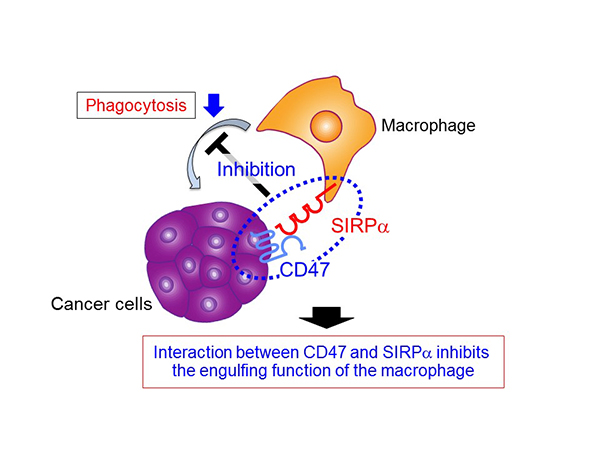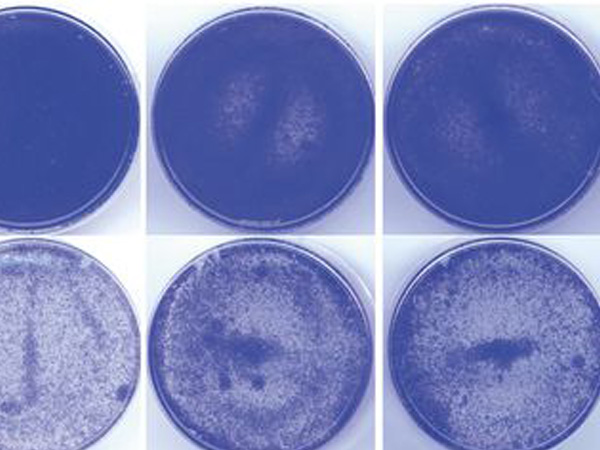Macrophages1 are a type of white blood cell that can engulf and destroy cancer cells. A research group led by Professor MATOZAKI Takashi, Associate Professor MURATA Yoji, and YANAGITA Tadahiko (Kobe University Department of Biochemistry and Molecular Biology, Division of Molecular and Cellular Signaling), discovered that by using an antibody2 for a particular protein found on macrophages, the macrophage is activated, and cancer cells are effectively eliminated. This discovery could lead to the development of new cancer treatments. The findings were published on January 12 in the online version of JCI Insight.
Cancer is a leading cause of death worldwide. In recent years, attention has been drawn by the effectiveness of treatment that targets specific proteins that express on both cancer cells and healthy cells including immune system cells (targeted therapy). However, issues with this treatment include the emergence of cancer cells resistant to targeted drugs, and side effects which differ from those for conventional anticancer drugs.
In their previous research, Professor Matozaki’s research group discovered that when the protein SIRPα, which is expressed on the cell membrane of macrophages, interacts with the protein CD47 which is expressed on the cell membrane of engulfment targets (such as cancer cells and senescent cells), the engulfment ability (phagocytosis) of the macrophages is inhibited (figure 1). This time, using immunodeficient mice3 subcutaneously injected with Raji cells (derived from human B-cell lymphoma), the group discovered that an anti-SIRPα antibody, which specifically reacts with SIRPα and inhibits the interaction of CD47 and SIRPα, helps a target drug known as rituximab4 to suppress tumor growth (figure 2A). Furthermore, they demonstrated that based on anti-SIRPα antibodies that inhibited CD47-SIRPα interaction, the phagocytic properties of macrophages were strengthened by rituximab. The researchers concluded that anti-SIRPα antibodies, which inhibit CD47-SIRPα interaction, could be highly effective against tumors by strengthening the phagocytosis of macrophages for cancer cells using target drugs such as rituximab (figure 2B).
The research group also discovered that both renal cell carcinoma and melanoma express high levels of SIRPα in humans and mice (figure 3A). In mice injected with mouse renal cell carcinoma (RENCA) cells or melanoma cells, they found that the sole administration of anti-SIRPα antibodies suppressed the growth (figure 3B) or metastasis of tumors. However, the suppression of tumor growth by anti-SIRPα antibody treatment was weakened in mice whose macrophages had been eliminated. In addition, from phagocytosis experiments using macrophages and renal cell carcinoma cells or melanoma cells, they showed that anti-SIRPα antibodies (1) induce phagocytosis of cancer cells by macrophages through the direct binding to SIRPα on cancer cells; (2) prevent the CD47-SIRPα interaction between cancer cells and macrophages, removing the restraints on phagocytosis of macrophages (activating the macrophages). Therefore, they concluded that the antitumor effects of anti-SIRPα antibodies on SIRPα-expressing cancer cells are based on this dual action (figure 3C).
Recently, anti-PD-1 antibodies5 that inhibit the functions of the PD-1 protein have demonstrated efficacy as anticancer drugs. The PD-1 protein is one of the immune checkpoint molecules6 for cytotoxic T-cells7. In mice subcutaneously implanted with mouse colon cancer cells (CT26 cells), the simultaneous administration of anti-SIRPα antibodies and anti-PD-1 antibodies has a stronger effect on inhibiting tumor growth compared to their separate administration (figure 4). The details of the action mechanism for anti-SIRPα antibodies are not fully understood, but simultaneous use of immune checkpoint inhibitors such as anti-PD-1 antibodies that act against cytotoxic T-cells and anti-SIRPα antibodies has a stronger antitumor effect than their separate use.
These findings have clarified that the antibodies for SIRPα, an immune checkpoint molecule for macrophages related to the innate immune system function, can be used as a new cancer treatment. In the future, as well as analyzing the mechanism for the antitumor effect of anti-SIRPα antibodies in more detail, while carefully assessing the safety of the treatment, anti-SIRPα antibodies can potentially be developed as anticancer drugs.


(A) Tumor-killing effects of rituximab strengthened by anti-SIRPα antibodies in a subcutaneous human B-cell lymphoma (Raji) model in immunodeficient mice
(B) A model of how the tumor-killing effects of targeted drugs are strengthened by anti-SIRPα antibodies

(A) High expression of SIRPα in human renal cell carcinoma and melanoma
(B) Tumor-killing effects of anti-SIRPα antibodies in mice with subcutaneous mouse renal cell carcinoma (RENCA). The anti-SIRPα antibodies inhibit the CD47-SIRPα binding, demonstrating a stronger anti-tumor effect compared to those without the binding inhibition
(C) A model of the dual-action anti-tumor effect of anti-SIRPα antibodies on renal cell carcinoma and melanoma, both of which show a high expression of SIRPα

Anti-SIRPα antibodies strengthen the tumor-killing effect of anti-PD-1 antibodies on subcutaneous mouse colon carcinoma (CT26).
Technical terms
- 1. macrophages
- Immune system cells that are specialized to engulf and destroy pathogens that invade the body (part of our innate immunity). These cells also engulf senescent cells and cancer cells, disposing of unnecessary cells within organisms.
- 2. antibody
- Produced from B cell lymphocytes, another type of immune system cell, this is a protein that can bond with specific molecules (such as proteins) known as antigens.
- 3. immunodeficient mice
- Mice which have lost the immune system cells such as T and B cells that are involved in the rejection of transplants from other organisms, and lack normal immune functions. For example, human cancer cells can be transplanted into immunodeficient mice which have lost T and B cells.
- 4. rituximab
- An antibody that specifically attaches to a protein known as CD20 that is expressed on the cell membrane. It is mainly used as an anticancer drug against malignant lymphomas. CD20 is known to exist in large quantities on healthy B cells, and among malignant lymphomas there are plenty of B-cell lymphomas.
- 5. Anti-PD-1 antibodies
- These antibodies attach specifically to the PD-1 protein, and the antibodies that obstruct the functions of PD-1 in particular are also known as immune checkpoint inhibitors.
- 6. immune checkpoint molecules
- Molecules that function as breaks for the immune reaction. For example, proteins known as PD-1 that are expressed on the cell membrane of cytotoxic T-cells act as immune checkpoint molecules. PD-1 can weaken the immune reaction of cytotoxic T-cells, which destroy cancer cells and infected cells.
- 7. cytotoxic T cells
- A type of lymphocyte immune system cell that can recognize and destroy cancer cells and cells which have been infected by a virus.
Journal information
- Title
- “Anti-SIRPα antibodies as a potential new tool for cancer immunotherapy”
- DOI
- 10.1172/jci.insight.89140
- Authors
- Tadahiko Yanagita,1,2 Yoji Murata,1 Daisuke Tanaka,1 Sei-ichiro Motegi,3 Eri Arai,4,5 Edwin Widyanto Daniwijaya,1 Daisuke Hazama,1 Ken Washio,1 Yasuyuki Saito,1 Takenori Kotani,1 Hiroshi Ohnishi,6 Per-Arne Oldenborg,7 Noel Verjan Garcia,8 Masayuki Miyasaka,8,9 Osamu Ishikawa,3 Yae Kanai,4,5 Takahide Komori,2 Takashi Matozaki1
- Division of Molecular and Cellular Signaling, Department of Biochemistry and Molecular Biology
- Department of Oral and Maxillofacial Surgery, Kobe University Graduate School of Medicine
- Department of Dermatology, Gunma University Graduate School of Medicine
- Division of Molecular Pathology, National Cancer Center Research Institute
- Department of Pathology, Keio University School of Medicine
- Department of Laboratory Sciences, Gunma University Graduate School of Health Sciences
- Department of Integrative Medical Biology, Section for Histology and Cell Biology, Umeå University
- Laboratory of Immunodynamics, Department of Microbiology and Immunology, Osaka University Graduate School of Medicine
- MediCity Research Laboratory, University of Turku, Finland
- Journal
- JCI Insight














